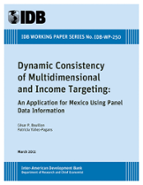Dynamic Consistency of Multidimensional and Income Targeting: An Application for Mexico Using Panel Data Information
Date
Mar 2011
This paper compares the dynamic consistency of targeting methodologies that use multidimensional welfare indicators with those based on means and proxy means tests using panel data from Mexico. To make these comparisons, an extension of the Alkire and Foster (2008) dual cutoff multidimensional poverty methodology is proposed. This extension provides a relative approach to multidimensional deprivation that ranks individuals according to an aggregate of their relative position in the distribution of a set of welfare attributes or outcomes. The extension gives particular importance to deprivations that affect smaller portions of the population, as these deprivations are especially critical in defining relative multidimensional welfare. The findings, disaggregated by geographical area (urban and rural), suggest that taking into account deprivation in multiple dimensions may lead to more dynamically consistent measures of well-being and thus more dynamically consistent targeting algorithms.



